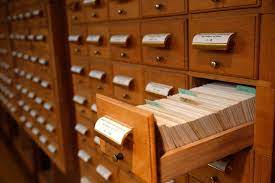Library Card Cabinet Cebu
A Library Card Cabinet Cebu cabinet is a great way to organize and store your library cards. It can keep all of your cards safe and organized in one place, while also providing easy access to them when needed. This article will provide helpful information about the different types of library card cabinets available and the benefits of having one at home or in the office. We’ll also discuss some tips for finding the best cabinet for your needs and how to make sure it lasts for many years to come.
A Library Card Cabinet Cebu is a storage system for library cards. It is typically a stand-alone unit that can be placed on a table or desk. The cabinet usually has multiple shelves and compartments to store different types of library cards.
When choosing a library card cabinet, it is important to consider the size and capacity of the unit.
The cabinet should be large enough to accommodate all of the library cards you need to store, but not so large that it takes up too much space.
There are many different styles and sizes of library card cabinets available, so it is important to shop around to find the right one for your needs.
Library card cabinets are a great way to keep your library cards organized and easy to find. They can also help protect your cards from damage and wear. If you have a lot of library cards, or if you frequently use them, a library card cabinet is a wise investment.
Libraries serve as a refuge for many people, offering a wide variety of books and other educational materials to the public. But what about the physical organization of all these items? How do libraries keep track of who has checked out what books? One of the most important tools for library organization is the library card cabinet. This piece of furniture may not get much recognition, but it is critical in allowing libraries to efficiently manage their collections. In this post, we will discuss the purpose and use of library card cabinets and how they are helping libraries become more efficient in managing their collections.
The benefits of using a library catalog allow a user to quickly learn what and what kinds of material are available, whether in physical copies or in the data bank. If it is printed on paper, the catalog will show you exactly where the various pieces of literature are housed. As a result, a user can get to them rapidly.
If particular literary works are not accessible in that library, the catalog may also alert the interlibrary loan services.
However, except from the fact that it may take users a while to browse a catalog with a lot of entries and that updating the catalog would require additional work from the library personnel, I do not see many drawbacks.
Cataloging is really required. Without a resource catalog, it would be impossible to find resources. Each item or resource in the library is cataloged to show where it is located. We couldn’t locate the books we need to find without categorization. The library is a place to find knowledge, not a source of it.
OPAC, or Online Public Access Catalog, is the overall name for it. But that is overly simplistic. There will be distinct designations for each library. Additionally, libraries are frequently combined into a single system, and this results in each system having its own title.
There are several types of libraries, and each will focus on particular kind of resources. For instance, public libraries could contain sections devoted to their City or State.
School libraries focus on current educational standards, parenting, personal interests, hobbies, crafts, music, and children’s books. Every government organization, every medical school, and most likely even your grandfather, has its own small library.
The expression “window to the collection” refers to the library catalog. A library offers a variety of services not found in the catalog.
You should visit whichever library is closest to you, to address your inquiry. Find the reference librarian by asking. Any query you may have will likely have an answer with him or her. He or she will find the information for you or direct you to a library.
A library has more resources than only the books and magazines it buys and subscribes to. It is a storehouse of knowledge and information, and the educated library staff frequently offers individualized services.
The functions of a library might vary greatly depending on its kind. Most libraries provide the following services:
a location (physical or digital) where people may collect knowledge in different media, whether for amusement or education
Librarians who can assist you in finding knowledge (and perhaps teach you how to assess its correctness and utility)
a location where a community may congregate (for activities or programs, or perhaps to provide refuge after inclement weather)
offers a range of options to learn new things (classes, resources, chatting to someone)
A shelter from the weather and a restroom are frequently need for physical locations.
Within the scope of its goal, a library may perform a variety of tasks. A library serves a variety of communities, some of which it concentrates on more than others. Most significantly, you probably haven’t even scratched the surface of what your library has to offer. Find out what more you can do at the library by starting a conversation with the staff and librarians.

